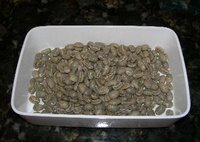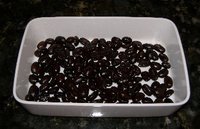 On to the actual roasting of beans. First, you need to find a supplier of green (unroasted) beans; sweetmarias is my provider of choice, but you may also be able to find a local roaster who is willing to sell you greens. The advantage of an online retailer is you will have access to many more varieties of beans. I like sweetmarias because they care about quality and will not sell old beans; they also offer some sampler packs so you can try a small amount of beans from a wide range of locales to see what you like best. To actually roast, you also need to invest in a roaster, from very cheap (certain -- but not all -- popcorn poppers, like the Westbend Poppery I/II, will do nicely as a starter roaster) to moderately priced (like the iRoast 2), to expensive (like the HotTop). If you are adventurous, you can also roast with a heat gun and dog bowl (!), a Stir Crazy popcorn popper bottom combined with a Turbo Oven top (aka the SC/TO beast), or even a large drum attached to a rotisserie fitted in a gas barbecue.
On to the actual roasting of beans. First, you need to find a supplier of green (unroasted) beans; sweetmarias is my provider of choice, but you may also be able to find a local roaster who is willing to sell you greens. The advantage of an online retailer is you will have access to many more varieties of beans. I like sweetmarias because they care about quality and will not sell old beans; they also offer some sampler packs so you can try a small amount of beans from a wide range of locales to see what you like best. To actually roast, you also need to invest in a roaster, from very cheap (certain -- but not all -- popcorn poppers, like the Westbend Poppery I/II, will do nicely as a starter roaster) to moderately priced (like the iRoast 2), to expensive (like the HotTop). If you are adventurous, you can also roast with a heat gun and dog bowl (!), a Stir Crazy popcorn popper bottom combined with a Turbo Oven top (aka the SC/TO beast), or even a large drum attached to a rotisserie fitted in a gas barbecue. I myself have a FreshRoast Plus, and a Poppery II I picked up off eBay for cheap as a backup roaster (again, note that you cannot use just any old popcorn popper; some designs can actually make the beans catch fire!). The Poppery is okay, but does not have the ability to catch the chaff so you have to make provision for that. The FR+ is a good starter roaster, using hot air to roast and a clever chaff collector on top to minimize the cleanup. I still roast in the garage because the smell of roasting beans, contrary to what one might think, is not all that pleasant (the roasted beans, on the other hand, smell great); this also gives me easy access to the wet/dry vac to clean up the chaff from the collector. The FR+ roasts fast, a batch of 70 grams (which is about enough for a pot) is done in about 6 minutes for a full city roast plus two minutes for cool-down, yielding about 54 grams of roasted coffee beans. Although I tend to roast a little dark (about full city on the roasting scale), you have total control over the degree of roast with the FR+ (and with most roasting methods). Since I drink about a mug per day, this is enough to last me three days, when I start the process over again.
I myself have a FreshRoast Plus, and a Poppery II I picked up off eBay for cheap as a backup roaster (again, note that you cannot use just any old popcorn popper; some designs can actually make the beans catch fire!). The Poppery is okay, but does not have the ability to catch the chaff so you have to make provision for that. The FR+ is a good starter roaster, using hot air to roast and a clever chaff collector on top to minimize the cleanup. I still roast in the garage because the smell of roasting beans, contrary to what one might think, is not all that pleasant (the roasted beans, on the other hand, smell great); this also gives me easy access to the wet/dry vac to clean up the chaff from the collector. The FR+ roasts fast, a batch of 70 grams (which is about enough for a pot) is done in about 6 minutes for a full city roast plus two minutes for cool-down, yielding about 54 grams of roasted coffee beans. Although I tend to roast a little dark (about full city on the roasting scale), you have total control over the degree of roast with the FR+ (and with most roasting methods). Since I drink about a mug per day, this is enough to last me three days, when I start the process over again. Finally, a note before I wrap up my treatment of homeroasting: there's no way I could do justice to the whole range of homeroasting methods and related matters in a single post or two. For the intrigued, I recommend the following websites:
Finally, a note before I wrap up my treatment of homeroasting: there's no way I could do justice to the whole range of homeroasting methods and related matters in a single post or two. For the intrigued, I recommend the following websites:sweetmarias is where I started my HR journey and where I recommend you start too (the website layout is not the greatest, but the content and quality of beans, not to mention Tom's devotion to furthering the art of HR, is beyond compare).
ineedcoffee is small site that gives a nice overview of the homeroasting process, including tips on the easiest homeroaster, the Westbend Poppery I/II (I have one as a backup to my FreshRoast).
coffeegeek is a good all-around coffee aficionado site and a good source of reviews;
homeroaster.com is a generic homeroasting site, with lots of links. Includes ways to hack coffee equipment and a super cheap method (heatgun and dog bowl) that supposedly gives great control and results (though I've never tried it).